Terms and Conditions Sample
If you've signed up for services before, then you might remember having to agree to the Terms and Conditions. While you probably did not read them, and most people don't, they are still a key part of the relationship between you and your users and customers.
A contract is optional in any business relationship. However, not having one can lead to serious and costly problems if there is a disagreement. When there is a legal dispute, one of the first questions is whether there was a contract in place.
A Terms and Conditions agreement is your contract with your users. Not having one only increases your risk for a negative outcome.
What are Terms and Conditions?
Terms and Conditions are the agreement between you as a provider of a product or service and the users of that product or service. Think of it as the terms of what you are offering to a user and the conditions under which they can use it. They include both what is permitted and what is not.
There is no law that requires you to have Terms and Conditions, but they are very good to have for several major reasons:
- The rights and responsibilities of both you and your user are made clear, which reduces the likelihood of confusion leading to a dispute.
- Proactively addressing possible future issues saves time and energy later if those issues do arise.
- You are protected in the event of a lawsuit.
Google clearly outlines the rights and responsibilities of their users in their Terms and Conditions.
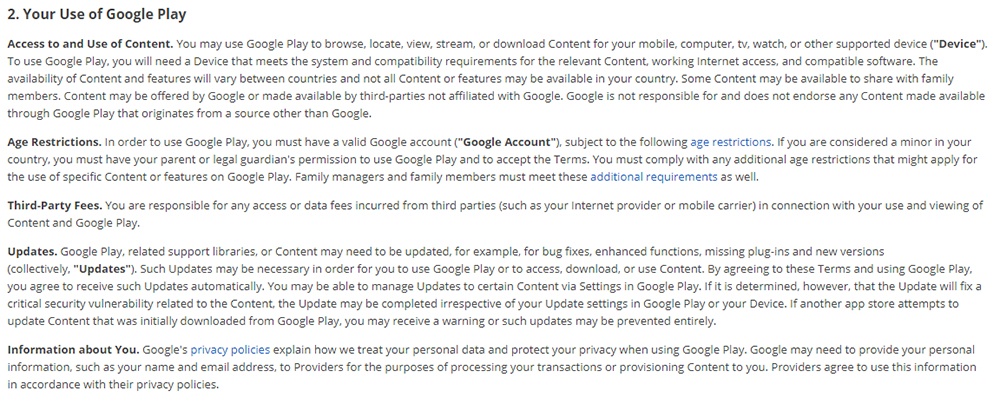
Terms and Conditions are a document that you can refer users to if they have questions about your product or service and their access to it.
Language that is easy for users to understand, while avoiding ambiguity that could lead to confusion, is best. You want your users to have a good grasp of your Terms and Conditions so that they follow them. Users cannot be expected to follow clauses they do not understand except by accident.
This agreement should also be as complete as possible, covering likely issues that might arise. You don't have to foresee every future problem, but the better job you do addressing the likely ones, the more protection your Terms and Conditions agreement will give you.
The primary benefit to you from a legal standpoint is protection in the event of a dispute between you and a customer or user. In an increasingly litigious society, having a clear agreement between you and your customer or user can save you time spent in court and expensive legal fees.
Facebook introduces their dispute clause with a plain language explanation of why this is important.
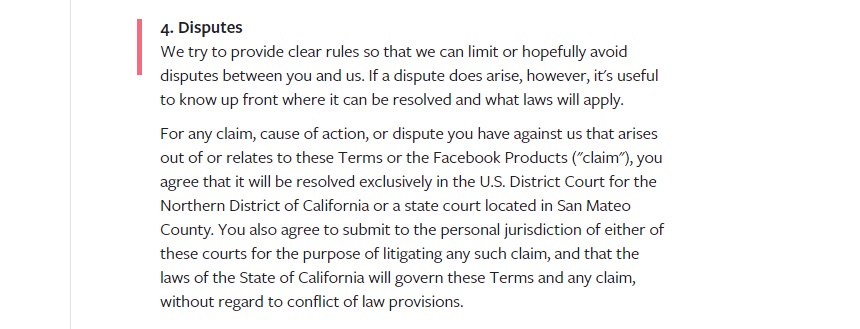
This is both protection for you if a user sues you and if a user does something that requires you to take action against them. Whether or not they actually read the agreement, once they have agreed, it becomes legally binding on both of you.
These general advantages translate into many specific benefits for you that make the effort to make and use Terms and Conditions worth your time.
- You keep control of your property, whether that be website content, app, or other intellectual property.
- You ensure that you are not liable for actions taken by users on or with your service that may harm others.
- You can avoid undesirable expenses by making limitations on warranties and guarantees clear in advance.
Basically, your Terms and Conditions are the framework of the relationship between you and your customer or user. They lay the groundwork for ensuring that things go smoothly and if they don't, that you can deal with the situation efficiently.
How to Create a T&C Agreement
Terms and conditions usually seem technical and complicated. You don't need to be intimidated by a perceived need to write legalese. The best terms and conditions are written in clear and simple language, easy to understand by your customers.
Wave includes both the technical language that is classic in a legal document and a plain language translation to help their users.
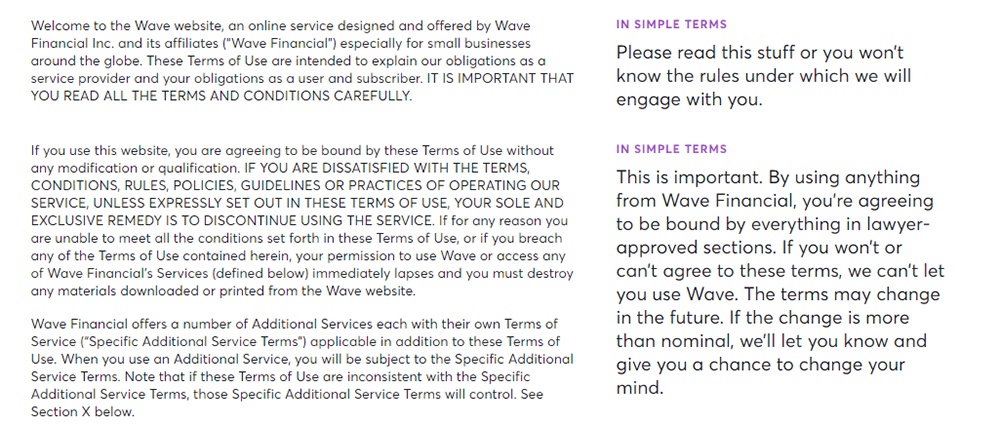
However, it can be helpful to speak with a lawyer to make sure all your bases are covered. This is a contract so making sure it is solid can be a good investment.
A good place to start is with your business itself by asking some questions:
- What are you offering?
- How do you want users to interact with what you are offering?
- How do you not want users to interact with what you are offering?
- What policies do you think it is important for users to know about before they sign up for or purchase what you are offering?
- How might a dishonest user try to take advantage of you?
- What misunderstandings might come up?
- What jurisdiction is most convenient for you in the event of a lawsuit?
These questions will give you a starting point to determine what your Terms and Conditions need to cover.
Your Terms and Conditions will be unique to your business purposes, but there are certain clauses that are generally useful.
A description of any warranties or guarantees you offer, including specifying that you don't have any if applicable, ensures that customers know what to expect. This can be a common area where unscrupulous individuals will try to take advantage of you.

There will be disputes with your users. It is inevitable, which is why it is vital to outline the process to handle any dispute that arises. If you want to avoid a legal proceeding if possible, this is the time to include a requirement for binding arbitration. Here's one from The Home Depot.

Your primary location for doing business is unlikely to be the same as the location of a user if a dispute becomes a legal proceeding. The law that applies in case a disagreement goes to court is an important element to include in your Terms and Conditions to ensure that the jurisdiction is convenient for you.
Here's this in action from YouTube.

If your service requires payment, you will want a clause that addresses that. Terms for payment, if applicable, including what happens if a customer does not pay according to those terms are important for the user to know. See this example from QuickBooks.
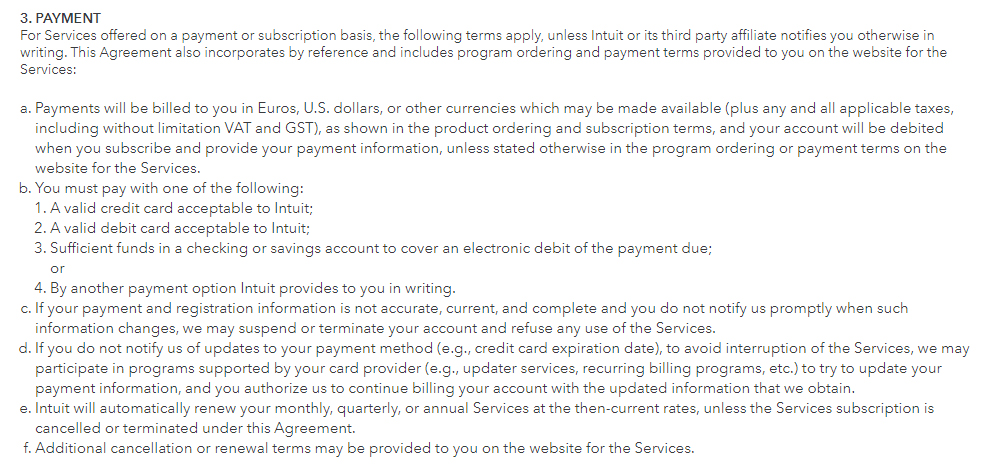
Since protecting your intellectual property is one of the major benefits of having Terms and Conditions, this is an area that also needs to be addressed. Here's an example from KeyBank.

There are generic templates available online that contain these common clauses.
In addition, it is important to consider the unique nature of your business as well based on the questions you asked yourself earlier. There may be clauses that you need that someone else does not, so be careful about relying on generic templates.
If you allow third-party content, a clause that clarifies the content is not yours or representing you can head off issues if a user posts something objectionable. Here's an example from Huggies.
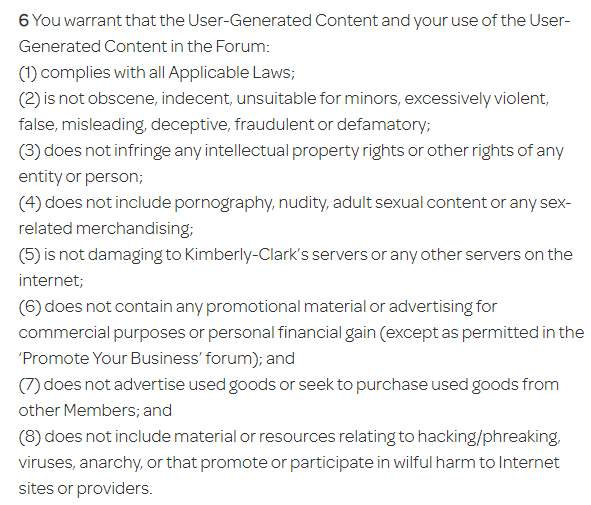
If you link to third-party websites, you would want to include a clause that clarifies that you are not responsible for the content on those websites. Here's an example from Kohl's.
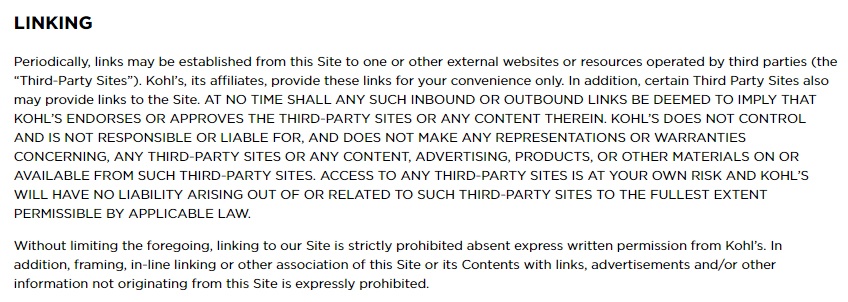
If you want to limit the age range of users to prevent use by children, a clause should explain that. While you cannot truly prevent individuals from signing up who are too young, if something goes wrong, you can point to the clause to show that they were in violation of your Terms and Conditions. Here's how Medium does it.

There are also services online that will generate Terms and Conditions for you. While these services may be convenient and a great start, you should also make sure to review the results you get. Their Terms and Conditions most likely limit their liability if a failure of their product results in a negative outcome for you.
How to Display Your T&C Agreement
You have your Terms and Conditions ready; now what? Displaying your Terms and Conditions has two parts.
First is laying out the clauses you've prepared within a single document or file to assist your users to understand them and make sure everything they need to understand is in one place. The second is ensuring that users see them and have the opportunity to read them.
Readability is key. Organizing your Terms and Conditions in a logical manner is as important as using language that is easy to understand.
You want clauses to be easy to find. You also want to lead your users through those clauses in a way that makes them easier to understand individually and as a whole. Terms and Conditions can be long and it is easy to get lost.
Using section and paragraph indicators to break up the text will help make the content easier to digest. Headings will give readers an idea of what the clauses in each section are about while numbers and letters assigned to categories and individual clauses can provide an easy way to navigate between different topics.
Terms and Conditions are often long and detailed. They can be intimidating. Making them user-friendly increases the chances that a current or potential user will read them.
In addition, the more clearly laid out your Terms and Conditions are, the better they can protect you legally should the need arise. You do not want there to be any way for a user to argue that they did not know what they were agreeing to.
Speaking of agreement, once you have settled on a layout for displaying your Terms and Conditions physically, you should consider how you will display the finished product to your current and potential future users.
One strategy is to have a dedicated page for your Terms and Conditions so that they are always available. This is helpful for you because then you can direct users to them in multiple ways.
Footer links can be included on any or all pages on your website. These ensure that a customer can access your terms and conditions at any time with a minimum of effort.
Links can also be included in email communications. Basically, there is no bad time to include a way for customers and users to access your Terms and Conditions. You never know when they will want to. Making it simple and easy reduces frustration.
You want customers and users to be able to access your Terms and Conditions whenever they want. You want them to abide by the agreement and be aware of the repercussions for violating it.
There are several ways to draw attention to your Terms and Conditions, and it can often be good to use more than one method just to be sure.
Whether you are selling a product or convincing people to sign up for a service, including your terms and conditions at the point where a visitor is converting to a customer makes sure that they have a clear opportunity to review them before finalizing their decision.
There are two main ways you can do this.
One is to include a link to the Terms and Conditions on the checkout or signup screen. This gives users the choice to read them if they want to. It saves room on the customer's screen and allows you to combine getting agreement with other parts of the purchase or signup process.
Twitter includes a link to their Terms of Service during the signup process.

The other is to require users to go through a screen with the Terms and Conditions displayed. This can be a step in the sign up or checkout process. You can also require users to scroll through the Terms and Conditions before moving to the next step. While this takes additional time, it also emphasizes that they are giving informed consent.
In general, it is a good idea to make your Terms and Conditions available to people in any situation where their activity would be impacted by those Terms and Conditions. If you need a visitor to be aware of them, make it easy to access them.
How to Get Agreement for Your T&C
A contract is not enforceable until both sides agree to it. Terms and Conditions work the same way. You need your customer to clearly give their approval and agreement. Without that agreement, your Terms and Conditions cannot legally protect you.
You should always get agreement to your Terms and Conditions before engaging in business with a client. Approval needs to happen before any business relationship, purchase, or service provision is finalized.
Clear and unambiguous consent is key.
While your display of your Terms and Conditions may or may not be combined with other elements of the process, you want there to be a clear link between the opportunity to read the Terms and Conditions and approval of them on the screen.
While you cannot make users read your Terms and Conditions, you can make their agreement to those Terms and Conditions as clear cut as possible.
The best way to get clear agreement is to include a step where the customer must take an action to indicate their agreement. This eliminates the possibility of a user claiming afterward that they did not actually consent.
For example, a checkbox requires the customer to click in the box. This is a great way to ensure that a customer is choosing to give their approval.
Another option, if you prefer your Terms and Conditions to be a separate screen that a user clicks through in the process, is to have the button to continue say "I Agree" or something similar. This conveys intent while also requiring approval of the Terms and Conditions in order for the checkout or signup process to be finalized.
Yahoo also includes a link to their Terms and Conditions during the signup process. Their "Continue" button serves as indication of your consent to those terms, which is clearly disclosed just above the button itself.

Conclusion
Terms and Conditions are not required by any law, but they are advisable. While the legal aspects of your business may not seem as interesting as building the business itself, they are an important protection for you. Terms and Conditions are often taken for granted, but if something does go wrong, you will be glad that you took the time.
They are often taken for granted because most people, including yourself perhaps, hardly ever read them. However, consent and approval is what matters.
As long as you make sure that the clauses accurately and completely reflect your business (as far as possible), make them easy to digest and understand, and obtain clear approval, they will serve as a kind of insurance policy to protect you if a clause is triggered.
You don't need legal advice either, but it can be helpful and serve to put your mind at ease. You can figure out what you need most and come up with a plan that works for your business. Every business is unique. Your Terms and Conditions won't look quite like anyone else's, but you also don't have to go it alone.